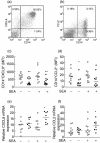Up-regulation of chemokine C-C ligand 2 (CCL2) and C-X-C chemokine 8 (CXCL8) expression by monocytes in chronic idiopathic urticaria
- PMID: 22132892
- PMCID: PMC3248094
- DOI: 10.1111/j.1365-2249.2011.04485.x
Up-regulation of chemokine C-C ligand 2 (CCL2) and C-X-C chemokine 8 (CXCL8) expression by monocytes in chronic idiopathic urticaria
Abstract
The disturbed cytokine-chemokine network could play an important role in the onset of diseases with inflammatory processes such as chronic idiopathic urticaria (CIU). Our main objectives were to evaluate the relation between proinflammatory chemokine serum levels from CIU patients and their response to autologous skin test (ASST) and basophil histamine release (BHR). We also aimed to assess the chemokine secretion by peripheral blood mononuclear cells (PBMC) upon polyclonal stimulus and to evaluate chemokine C-C ligand 2/C-X-C chemokine 8 (CCL2/CXCL8) and Toll-like receptor-4 (TLR-4) expression in monocytes. We observed significantly higher serum levels of the CXCL8, CXCL9, CXCL10 and CCL2 in CIU patients compared to the healthy group, regardless of the BHR or ASST response. The basal secretion of CCL2 by PBMC or induced by Staphylococcus aureus enterotoxin A (SEA) was higher in CIU patients than in the control group, as well as for CXCL8 and CCL5 secretions upon phytohaemagglutinin stimulation. Also, up-regulation of CCL2 and CXCL8 mRNA expression was found in monocytes of patients upon SEA stimulation. The findings showed a high responsiveness of monocytes through CCL2/CXCL8 expression, contributing to the creation of a proinflammatory environment in CIU.
© 2011 The Authors. Clinical and Experimental Immunology © 2011 British Society for Immunology.
Figures




Similar articles
-
Statin effects on regulatory and proinflammatory factors in chronic idiopathic urticaria.Clin Exp Immunol. 2011 Nov;166(2):291-8. doi: 10.1111/j.1365-2249.2011.04473.x. Clin Exp Immunol. 2011. PMID: 21985375 Free PMC article.
-
Peripheral blood mononuclear cells from neovascular age-related macular degeneration patients produce higher levels of chemokines CCL2 (MCP-1) and CXCL8 (IL-8).J Neuroinflammation. 2017 Feb 23;14(1):42. doi: 10.1186/s12974-017-0820-y. J Neuroinflammation. 2017. PMID: 28231837 Free PMC article.
-
Interleukin-6 induces monocyte chemotactic protein-1 in peripheral blood mononuclear cells and in the U937 cell line.Blood. 1998 Jan 1;91(1):258-65. Blood. 1998. PMID: 9414293
-
The Role of Chemokines in Cardiovascular Diseases and the Therapeutic Effect of Curcumin on CXCL8 and CCL2 as Pathological Chemokines in Atherosclerosis.Adv Exp Med Biol. 2021;1328:155-170. doi: 10.1007/978-3-030-73234-9_11. Adv Exp Med Biol. 2021. PMID: 34981477 Review.
-
The Role of Chemokines in Obesity and Exercise-Induced Weight Loss.Biomolecules. 2024 Sep 4;14(9):1121. doi: 10.3390/biom14091121. Biomolecules. 2024. PMID: 39334887 Free PMC article. Review.
Cited by
-
Elevated Plasma Level of Interferon-λ1 in Chronic Spontaneous Urticaria: Upregulated Expression in CD8(+) and Epithelial Cells and Induction of Inflammatory Cell Accumulation.Mediators Inflamm. 2016;2016:5032051. doi: 10.1155/2016/5032051. Epub 2016 Jun 30. Mediators Inflamm. 2016. PMID: 27445435 Free PMC article.
-
Trypanosoma cruzi SSP4 Amastigote Protein Induces Expression of Immunoregulatory and Immunosuppressive Molecules in Peripheral Blood Mononuclear Cells.J Trop Med. 2012;2012:829139. doi: 10.1155/2012/829139. Epub 2012 Nov 1. J Trop Med. 2012. PMID: 23209478 Free PMC article.
-
Involvement of CCL2 and CH25H Genes and TNF signaling pathways in mast cell activation and pathogenesis of chronic spontaneous urticaria.Front Immunol. 2023 Aug 14;14:1247432. doi: 10.3389/fimmu.2023.1247432. eCollection 2023. Front Immunol. 2023. PMID: 37646031 Free PMC article.
-
Research progress in the pathogenesis of chronic urticaria.Zhong Nan Da Xue Xue Bao Yi Xue Ban. 2023 Oct 28;48(10):1602-1610. doi: 10.11817/j.issn.1672-7347.2023.230037. Zhong Nan Da Xue Xue Bao Yi Xue Ban. 2023. PMID: 38432889 Free PMC article. Chinese, English.
-
Stress, pseudoallergens, autoimmunity, infection and inflammation in chronic spontaneous urticaria.Allergy Asthma Clin Immunol. 2019 Sep 11;15:56. doi: 10.1186/s13223-019-0372-z. eCollection 2019. Allergy Asthma Clin Immunol. 2019. PMID: 31528163 Free PMC article. Review.
References
-
- Greaves M. Chronic urticaria. J Allergy Clin Immunol. 2000;105:664–72. - PubMed
-
- Hide M, Francis DM, Grattan CE, Hakimi J, Kochan JP, Greaves MW. Autoantibodies against the high-affinity IgE receptor as a cause of histamine release in chronic urticaria. N Engl J Med. 1993;328:1599–604. - PubMed
-
- Kaplan AP, Greaves M. Pathogenesis of chronic urticaria. Clin Exp Allergy. 2009;39:777–87. - PubMed
-
- Sabroe RA, Francis DM, Barr RM, et al. Anti-Fc(episilon)RI auto antibodies and basophil histamine releasability in chronic idiopathic urticaria. J Allergy Clin Immunol. 1998;102(Pt 1):651–8. - PubMed
-
- Sabroe RA, Grattan CE, Francis DM, Barr RM, Kobza Black A, Greaves MW. The autologous serum skin test: a screening test for autoantibodies in chronic idiopathic urticaria. Br J Dermatol. 1999;140:446–52. - PubMed
Publication types
MeSH terms
Substances
LinkOut - more resources
Full Text Sources
Medical
Research Materials

